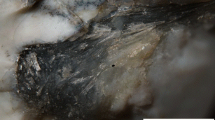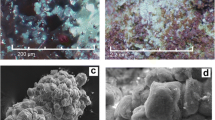Abstract
A new mineral kobyashevite, Cu5(SO4)2(OH)6·4H2O (IMA 2011–066), was found at the Kapital’naya mine, Vishnevye Mountains, South Urals, Russia. It is a supergene mineral that occurs in cavities of a calcite-quartz vein with pyrite and chalcopyrite. Kobyashevite forms elongated crystals up to 0.2 mm typically curved or split and combined into thin crusts up to 1 × 2 mm. Kobyashevite is bluish-green to turquoise-coloured. Lustre is vitreous. Mohs hardness is 2½. Cleavage is {010} distinct. D(calc.) is 3.16 g/cm3. Kobyashevite is optically biaxial (−), α 1.602(4), β 1.666(5), γ 1.679(5), 2 V(meas.) 50(10)°. The chemical composition (wt%, electron-microprobe data) is: CuO 57.72, ZnO 0.09, FeO 0.28, SO3 23.52, H2O(calc.) 18.39, total 100.00. The empirical formula, calculated based on 18 O, is: Cu4.96Fe0.03Zn0.01S2.01O8.04(OH)5.96·4H2O. Kobyashevite is triclinic, \( P\overline{\,1 } \), a 6.0731(6), b 11.0597(13), c 5.5094(6) Å, α 102.883(9)°, β 92.348(8)°, γ 92.597(9)°, V 359.87(7) Å3, Z = 1. Strong reflections of the X-ray powder pattern [d,Å-I(hkl)] are: 10.84–100(010); 5.399–40(020); 5.178–12(110); 3.590–16(030); 2.691–16(20–1, 040, 002), 2.653–12(04–1, 02–2), 2.583–12(2–11, 201, 2–1–1), 2.425–12(03–2, 211, 131). The crystal structure (single-crystal X-ray data, R = 0.0399) сontains [Cu4(SO4)2(OH)6] corrugated layers linked via isolated [CuO2(H2O)4] octahedra; the structural formula is CuCu4(SO4)2(OH)6·4H2O. Kobyashevite is a devilline-group member. It is named in memory of the Russian mineralogist Yuriy Stepanovich Kobyashev (1935–2009), a specialist on mineralogy of the Urals.





Similar content being viewed by others
Notes
In some papers the name “strandbergite” is used for this compound formed in the result of corrosion of artificial metallic objects containing copper (He 2002).
References
Adiwidjaja G, Friese K, Klaska K-H, Schlüter J (1996) The crystal structure of christelite, Zn3Cu2(SO4)2(OH)6·4H2O. Z Kristallogr 211:518–521
Brese NE, O’Keeffe M (1991) Bond-valence parameters for solids. Acta Crystallogr B42:192–197
Effenberger H (1984) Verfeinerung der Kristallstruktur von Kupfer(II)hydroxichlorid, Cu(OH)Cl. Monatsh Chem 115:725–730
Elliott P, Pring A (2010) Aldridgeite, IMA 2010–029. CNMNC Newsletter 4, August 2010, page 776. Mineral Mag 74:773–776
Ferraris G, Ivaldi G (1988) Bond valence vs bond length in O···O hydrogen bonds. Acta Crystallogr B44:341–344
Gentsch M, Weber K (1984) Structure of langite, Cu4[(OH)6|(SO4)2]·3H2O. Acta Crystallogr C40:1309–1311
Giester G, Rieck B, Brandstätter F (1998) Niedermayrite, Cu4Cd(SO4)2(OH)6·4H2O, a new mineral from the Lavrion Mining District, Greece. Mineral Petrol 63:19–34
Hawthorne FC (1985) Refinement of the crystal structure of botallackite. Mineral Mag 49:87–89
Hawthorne FC, Groat LA (1985) The structure of wroewolfeite, a mineral with [Cu4(OH)6(SO4)(H2O)] sheets. Amer Mineral 70:1050–1055
He W (2002) Atmospheric corrosion and runoff processes on copper and zinc as roofing materials. Doctoral thesis. Royal Institute of Technology, Stockholm
Kobyashev YS, Nikandrov SN (2007) Minerals of the urals (Mineral Species and Varieties). KVADRAT Publishing, Ekaterinburg, in Russian
Kobyashev YS, Makagonov EP, Nikandrov SN (1998) Minerals of the Vishnevye and Potaniny Mountains. Ilmeny State Reserve Publishing, Miass, in Russian
Krause W, Täuber H (1992) Zum Kenntnisstand der Minerale Serpierit, Orthoserpierit und Devillin. Aufschluss 43:1–25
Libowitzky E (1999) Correlation of O–H stretching frequencies and O–H···O hydrogen bond lengths in minerals. Monatsh Chem 130:1047–1059
Mandarino JA (1981) The gladstone-dale relationship: part IV. The compatibility concept and its application. Can Mineral 19:441–450
Medenbach O, Gebert W (1993) Lautenthalite, PbCu4[(OH)6|(SO4)2]·3H2O, the Pb analogue of devillite: a new mineral from the Harz mountains, Germany. N Jb Mineral Mh 401–407
Mellini M, Merlino S (1978) Ktenasite, another mineral with 2∞[(Cu, Zn)2(OH)3O)]− octahedral sheets. Z Kristallogr 147:129–140
Mellini M, Merlino S (1979) Posnjakite: 2 ∞[Cu4(OH)6(H2O)O]− octahedral sheets in its structure. Z Kristallogr 149:249–257
Pushcharovsky DY, Lima-de-Faria J, Rastsvetaeva RK (1998) Main structural subdivisions and structural formulas of sulphate minerals. Z Kristallogr 213:141–150
Sabelli C (1982) Campigliaite, Cu4Mn(SO4)2(OH)6·4H2O, a new mineral from Campiglia Marittima, Tuscany. Italy. II. Crystal structure. Amer Mineral 67:388–393
Sabelli C, Zanazzi PF (1968) The structure of serpierite. Acta Crystallogr B24:1214–1221
Sabelli C, Zanazzi PF (1972) The crystal structure of devillite. Acta Crystallogr B28:1182–1189
Schlüter J, Klaska K-H, Gebhard G (2000) Belloite, Cu(OH)Cl, a new mineral from Sierra Gorda, Antofagasta, Chile. N Jb Miner Mh 67–73
Sheldriсk GM (2008) A short history of SHELX. Acta Crystallogr A64:112–122
Strandberg H, Langer V, Johansson L-G (1995) Structure of Cu2.5(OH)3SO4·2H2O: a novel corrosion product of copper. Acta Chem Scand 49:5–10
Acknowledgments
This paper is dedicated to Josef Zemann for his contribution in the crystal chemistry of supergene minerals, including copper sulfates.
We are grateful to two anonymous referees and the editor Herta Effenberger for useful comments. Our work was supported by the Russian Foundation for Basic Research, grants nos. 11-05-00397-a, 11-05-00407-a and 12-05-00250-а, and by the Foundation of the President of the Russian Federation, grant no. NSh-2883.2012.5. X-ray powder-diffraction study was carried out in the SPbSU X-ray Diffraction Resource Center.
Author information
Authors and Affiliations
Corresponding author
Additional information
Editorial handling: H. Effenberger
Rights and permissions
About this article
Cite this article
Pekov, I.V., Zubkova, N.V., Yapaskurt, V.O. et al. Kobyashevite, Cu5(SO4)2(OH)6·4H2O, a new devilline-group mineral from the Vishnevye Mountains, South Urals, Russia. Miner Petrol 107, 201–210 (2013). https://doi.org/10.1007/s00710-012-0236-4
Received:
Accepted:
Published:
Issue Date:
DOI: https://doi.org/10.1007/s00710-012-0236-4




